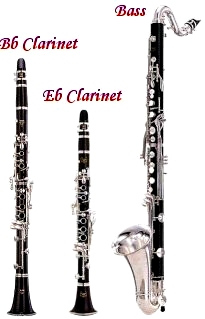|
Xtend
 Listen
Listen
 Jokes
Jokes
 Evolution
Evolution
 Animation
Animation
 Internet
Internet
 Projects
Projects
 Dictionary
Dictionary
 Home
Home
|

The Clarinet
The modern clarinet was built in the 17th century by Christoph Dener,
however, the instruments is based on more ancient
instrument, some of which can be found in ancient Egypt. Mozart
was built in the 17th century by Christoph Dener,
however, the instruments is based on more ancient
instrument, some of which can be found in ancient Egypt. Mozart was one of the first composers to include it in his work (the
clarinet concerto he wrote two months before his death, is considered
one of the heights of his work), yet its importance grew even more in the
19th century, when Thoebald Bohm, installed
the system of leverages and stops that allow convenient paying.
Apart from the common soprano clarinet
was one of the first composers to include it in his work (the
clarinet concerto he wrote two months before his death, is considered
one of the heights of his work), yet its importance grew even more in the
19th century, when Thoebald Bohm, installed
the system of leverages and stops that allow convenient paying.
Apart from the common soprano clarinet ,
there are also other members of this family - the alto, the tenor
and bass clarinets. In an orchestra, players sometimes
use clarinets of different tunings, for playing hard keys comfortably.
Brahms's ,
there are also other members of this family - the alto, the tenor
and bass clarinets. In an orchestra, players sometimes
use clarinets of different tunings, for playing hard keys comfortably.
Brahms's clarinet Quintet and the A
minor Trio for clarinet, cello and piano, Op. 114, are two of the
pearls of its chamber repertory; Debussy
clarinet Quintet and the A
minor Trio for clarinet, cello and piano, Op. 114, are two of the
pearls of its chamber repertory; Debussy wrote his Rhapsody for clarinet and orchestra;
Weber
wrote his Rhapsody for clarinet and orchestra;
Weber composed several concerti for clarinet and orchestra, the best-known
among those is the A minor concerto, Op. 26.
In the traditional Jewish music
composed several concerti for clarinet and orchestra, the best-known
among those is the A minor concerto, Op. 26.
In the traditional Jewish music ,
the clarinet holds a central role in 19th century
klezmer bands in Eastern Europe. Its
gentle sounds ,
the clarinet holds a central role in 19th century
klezmer bands in Eastern Europe. Its
gentle sounds and glissando
and glissando options enable a range of emotional expression from laughter to
crying and mourning
options enable a range of emotional expression from laughter to
crying and mourning .
Klezmer music, the so-called Jewish "soul music", embraced this
instrument, and players like Giora Fiedman
and Israel Zohar transmit the same warmth
and enthusiasm of Jewish music with their clarinet.
The clarinet was also adopted in jazz .
Klezmer music, the so-called Jewish "soul music", embraced this
instrument, and players like Giora Fiedman
and Israel Zohar transmit the same warmth
and enthusiasm of Jewish music with their clarinet.
The clarinet was also adopted in jazz  music, though not with the same exhilaration as the saxophone
music, though not with the same exhilaration as the saxophone .
Benny Goodman .
Benny Goodman is the most famous clarinet jazz player, and composer Aaron
Copland
is the most famous clarinet jazz player, and composer Aaron
Copland even wrote, by his request, a concerto for clarinet
and a string orchestra, in which he combined elements of jazz and
Southern-American music.
even wrote, by his request, a concerto for clarinet
and a string orchestra, in which he combined elements of jazz and
Southern-American music.

 Wind
MIDI controller Wind
MIDI controller
|
Composers

Mozart

Debussy

von Weber

Brahms
|